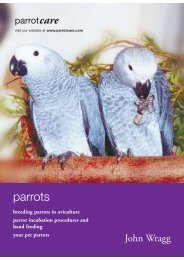incubation procedures and hand feeding - Parrotcare
incubation procedures and hand feeding - Parrotcare
incubation procedures and hand feeding - Parrotcare
You also want an ePaper? Increase the reach of your titles
YUMPU automatically turns print PDFs into web optimized ePapers that Google loves.
parrotcare visit our website at www.parrotcare.com<br />
development is normal. If during physical examination a<br />
chick appears to be normal, it is of greater value than<br />
weight data. It is surprising that at the end of the h<strong>and</strong><br />
rearing exercise <strong>and</strong> the chick is fully weaned <strong>and</strong> on the<br />
perch, it will have achieved the target weight <strong>and</strong> size if<br />
the <strong>procedures</strong> described have been adhered to.<br />
problem solving<br />
There are many problems that can occur in the h<strong>and</strong><br />
rearing room most of which can be put down to poor<br />
management practices. Problems are legion <strong>and</strong> too<br />
many to mention in a small booklet such as this. Going<br />
back to one of my opening remarks on h<strong>and</strong> rearing,<br />
very few chicks should perish during the h<strong>and</strong> rearing<br />
procedure even from day old <strong>and</strong> should be no more<br />
than 2-3%. If the <strong>procedures</strong> outlined in this booklet are<br />
adhered to, then problems requiring medical attention<br />
should be few <strong>and</strong> far between. If viral or bacterial<br />
infections invade the chick, then there is very little the<br />
h<strong>and</strong> rearer can do to cure it. Prevention is far better<br />
than cure <strong>and</strong> a very detailed management plan should<br />
be put into effect <strong>and</strong> adhered to.<br />
weaning<br />
Once your baby parrot has reached this stage the job is<br />
almost complete. The most amazing stories have been<br />
heard about weaning but at PARROTCARE there have<br />
never been any major<br />
problems weaning<br />
the baby parrot onto<br />
hard food. I am now<br />
of the firm belief<br />
that weaning onto a<br />
formulated complete<br />
diet or pellet is the<br />
easiest <strong>and</strong> most<br />
successful way of<br />
weaning the baby<br />
parrot The colourful<br />
nature of the<br />
pellets <strong>and</strong> their<br />
crunchiness appears<br />
to attract the baby<br />
<strong>and</strong> although this<br />
starts as play it soon<br />
ends up with the bird<br />
being fully weaned. It is possible to buy interim or<br />
weaning diets that are produced for that express<br />
purpose. You can not starve a baby parrot into<br />
submission when it comes to becoming independent. At<br />
PARROTCARE we continue to feed the baby until it no<br />
longer requires the food from either a psychological or<br />
nutritional st<strong>and</strong>point. By simply feeling the bird’s crop it<br />
is possible to establish whether it is <strong>feeding</strong> correctly.<br />
Over the past 20 years we have tried every weaning trick<br />
available. Lorys are by far the easiest of all parrots to<br />
wean. The weaning process can take as little as one day<br />
as food is consumed in liquid form, merely introducing<br />
the lory to the liquid diet warmed up is sufficient. It is<br />
often a good idea to put the spoon in the nectar <strong>and</strong> the<br />
bird is clever enough to put two <strong>and</strong> two together <strong>and</strong><br />
realise that simply playing about the spoon is sufficient<br />
to encourage eating <strong>and</strong> drinking.<br />
Much more difficult are the larger parrots, Eclectus <strong>and</strong><br />
Macaws will allow you to h<strong>and</strong> feed them for as long as<br />
you want, even though they are totally independent in<br />
terms of food consumption. They often continue to beg<br />
for food from the h<strong>and</strong> rearer whenever he enters the<br />
room. Strangely enough when a person who is not the<br />
h<strong>and</strong> rearer enters the room the begging ceases, proving<br />
the need for food is psychosomatic <strong>and</strong> not nutritional.<br />
It is important to know the difference. As mentioned<br />
previously we now wean all babies onto the complete<br />
diet, with the addition of fruit <strong>and</strong> vegetables in a second<br />
bowl. At PARROTCARE we have found this to be easily<br />
the quickest <strong>and</strong> most satisfactory way of weaning.<br />
The number of unweaned chicks finding their way<br />
onto the pet market is quite alarming <strong>and</strong> at PARROT-<br />
CARE it is a policy not to allow any parrot to leave the<br />
premises for at least 10-14 days after we feel it is totally<br />
independent <strong>and</strong> <strong>feeding</strong> himself. Purchasing a parrot<br />
that is not properly weaned can be an extremely<br />
raumatic experience for both owner <strong>and</strong> parrot.<br />
The parrot may not survive the ordeal.<br />
Throughout the weaning process for all parrots, there is<br />
a weight loss probably in the region of 10%. The baby<br />
will tell you when it does not require any further food. If



